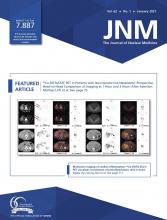Humana, the feminine for humanus in Latin, is taken to mean “human (of man, people)”; “humane”; “cultured, refined” (1).
Johannes Czernin
Andrei Iagaru
Humana, a for-profit American health insurance company with 46,000 employees and more than 20 million members in the United States, with a 2019 revenue of $56.9 billion and a profit of $2.7 billion, recently announced a new coverage policy for fusion imaging (Humana Policy Decision HCS-0506-010 (2)). Humana has concluded that several PET/CT imaging applications are considered experimental and not eligible for coverage. All these indications have been covered by the Centers for Medicare and Medicaid Services for many years on the basis of extensive data supporting their positive impact on patient care (3). Humana’s recent coverage—or, better, noncoverage—document, authored by an anonymous group of “experts,” excludes from coverage cardiac PET imaging of myocardial stress/rest perfusion and viability, as well as imaging of gastric and esophageal cancer (2). It also excludes coverage for diagnostic CT in conjunction with PET for most cancers.
The document lists a long litany of 191 references, most from the late 1990s and early 2000s, including Food and Drug Administration 510(k) filings for various devices. We are now in 2020, and new high-quality evidence supporting the use of PET/CT exists beyond Humana’s bizarre selection of references. For example, the Humana policy decision allows for PET imaging “During and after treatment of Hodgkin lymphoma; OR [sic] More accurate characterization of pancreatic or thymic tumors…; OR [sic] Posttreatment monitoring of head and neck cancer…; OR [sic] When standard staging/restaging diagnostic imaging studies are inconclusive and further characterization is needed to make management decisions.”
In addition to Humana’s odd use of the word OR in this context, its coverage/noncoverage decision makes no sense at all. What would be the point of imaging patients with lymphoma or head and neck cancer during or after treatment if no baseline scan is available for comparison? How would one assess treatment efficacy? What is so different between thymic cancer and esophageal cancer other than the much more extensive literature addressing imaging of esophageal and gastric cancer with 18F-FDG PET/CT? In other words, why would the glycolytic phenotype imaged with PET be less informative in one cancer than in another?
The document does not list its authors, who conclude that Humana patients may not be eligible under the plan for PET with concurrently acquired CT for any indications other than those listed above, including but not limited to “Cardiac indications; (OR) [sic] Gastric or esophageal oncologic indications; OR [sic] Neurologic indications; OR [sic] Total body PET/CT (μExplorer [University of California, Davis]) for screening (eg, cancer) [sic].” How and why is a single device highlighted and the most appropriate uses of PET/CT ignored? Perhaps the development and purpose of the μExplorer was misunderstood? And here is another highlight referring to all the above items: “These are considered experimental/investigational as they are not…widely used…for the proposed uses as reported in nationally recognized peer-reviewed medical literature published in the English language.”
And when we hope that the quality of this decision document had reached its lowest point, we have a rude awakening: we now learn that “Diagnostic CT scan used in conjunction with PET/CT,” and, interestingly, in conjunction with PET/MRI (how would this work?) and SPECT/CT or SPECT/MRI (is this a venture to preemptively decline reimbursement for such technology?), would not be covered (by now, the informed reader understands that we omitted the obligatory OR connecting or disconnecting these items).
In a swift and tabulated move throughout most of the body regions, Humana disallowed coverage for diagnostic-quality CT for PET/CT. This decision is obviously a great disservice to patients, who now have to return to clinics twice to get information that would otherwise be available in a single session. Humana invokes the bizarre argument that a PET exam with diagnostic CT would expose patients to more radiation than is incurred from separately performed diagnostic CT and PET/nondiagnostic CT. In fact, the opposite is true. But the approach is also evidently more expensive than a single fully diagnostic scan.
The document is equally irrational and misleading regarding SPECT/CT and PET/MRI. Decades of high-quality data showing that in the case of hybrid imaging the sum is truly better than the parts are ignored.
The nonsense of all these decisions is blatantly apparent. It is also apparent that the anonymous authors had extremely limited insights into standard-of-care and state-of-the-art diagnostic imaging, cancer care, and care of cardiovascular patients. The alternative is that the document’s goal is to mislead the public in an attempt to block access to technology that is the standard of care in 2020. We are puzzled by the authors’ misconception about the cost of PET/CT imaging, which is marginal in cancer care and cardiovascular diseases (4). In fact, it is quite likely that the bureaucratic processes involved in designing the decision documents and monitoring implementation and compliance cost much more than the diagnostic tests.
Asking experts for input would provide Humana members with better access to care, save costs, and improve outcomes. Arbitrary edicts such as this one do nothing to address such needs. Reimbursement by the Centers for Medicare and Medicaid Services for 18F-FDG PET was based on complex decision-tree sensitivity analyses for cost effectiveness (5) and on large, national, prospective studies evaluating changes in management (6). Until the anonymous authors provide solid arguments, we will be relentless in opposing such actions.
Regarding this second sequel to “The Injustice of Being Judged by the Errors of Others” (7,8), we hope that patients and physicians will join the discussion, make their voices heard, and demand an immediate reversal of this ill-informed and wrong decision.
- © 2021 by the Society of Nuclear Medicine and Molecular Imaging, Inc.









